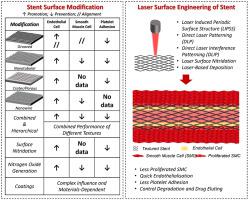Bioactive Materials ( IF 18.9 ) Pub Date : 2021-08-28 , DOI: 10.1016/j.bioactmat.2021.08.023 J Dong 1 , M Pacella 1 , Y Liu 1, 2 , L Zhao 1

|
Late in-stent thrombus and restenosis still represent two major challenges in stents’ design. Surface treatment of stent is attracting attention due to the increasing importance of stenting intervention for coronary artery diseases. Several surface engineering techniques have been utilised to improve the biological response in vivo on a wide range of biomedical devices. As a tailorable, precise, and ultra-fast process, laser surface engineering offers the potential to treat stent materials and fabricate various 3D textures, including grooves, pillars, nanowires, porous and freeform structures, while also modifying surface chemistry through nitridation, oxidation and coatings. Laser-based processes can reduce the biodegradable materials' degradation rate, offering many advantages to improve stents’ performance, such as increased endothelialisation rate, prohibition of SMC proliferation, reduced platelet adhesion and controlled corrosion and degradation. Nowadays, adequate research has been conducted on laser surface texturing and surface chemistry modification. Laser texturing on commercial stents has been also investigated and a promotion of performance of laser-textured stents has been proved.
In this critical review, the influence of surface texture and surface chemistry on stents performance is firstly reviewed to understand the surface characteristics of stents required to facilitate cellular response. This is followed by the explicit illustration of laser surface engineering of stents and/or related materials. Laser induced periodic surface structure (LIPSS) on stent materials is then explored, and finally the application of laser surface modification techniques on latest generation of stent devices is highlighted to provide future trends and research direction on laser surface engineering of stents.
中文翻译:

表面工程和基于激光的工艺在支架上的应用——最新发展综述
晚期支架内血栓和再狭窄仍然是支架设计中的两大挑战。由于支架介入治疗冠状动脉疾病的重要性日益增加,支架的表面处理引起了人们的关注。几种表面工程技术已被用于改善体内生物反应在广泛的生物医学设备上。作为一种可定制、精确和超快速的过程,激光表面工程提供了处理支架材料和制造各种 3D 纹理的潜力,包括凹槽、柱子、纳米线、多孔和自由形状结构,同时还通过氮化、氧化和涂料。基于激光的工艺可以降低可生物降解材料的降解率,为提高支架性能提供许多优势,例如提高内皮化率、抑制 SMC 增殖、减少血小板粘附以及控制腐蚀和降解。目前,已经对激光表面纹理化和表面化学改性进行了充分的研究。
在这篇批判性评论中,首先回顾了表面纹理和表面化学对支架性能的影响,以了解促进细胞反应所需的支架表面特性。接下来是支架和/或相关材料的激光表面工程的明确说明。然后探索了支架材料上的激光诱导周期表面结构(LIPSS),最后重点介绍了激光表面改性技术在最新一代支架装置上的应用,为支架激光表面工程的未来发展趋势和研究方向提供了方向。



























 京公网安备 11010802027423号
京公网安备 11010802027423号